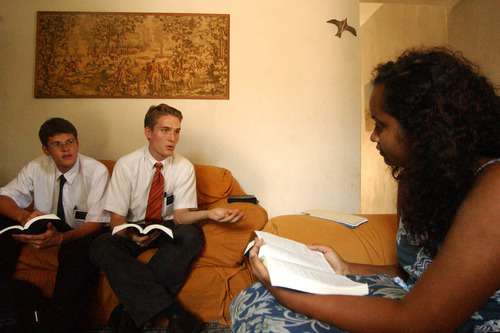This is an archived article that was published on sltrib.com in 2011, and information in the article may be outdated. It is provided only for personal research purposes and may not be reprinted.
Mormon researchers who pay close attention to LDS Church growth throughout the world see a hint of improvement in the number of converts who progress from baptism to become fully active, faithful Mormons.
A key piece of evidence, says Matt Martinich, a Colorado-based researcher, is in the number of wards and branches in each country.
For decades, say Martinich and colleague David Stewart, the church had poor retention rates, particularly in Latin America. That resulted in a gap between the membership numbers the church reports — 13.8 million in 2009 — and the number of active members of The Church of Jesus Christ of Latter-day Saints.
The two estimate there are 4 million to 5 million active Mormons in the world, roughly 80 percent of them in the Western Hemisphere.
But efforts by the church in the past decade, including the 2004 missionary manual Preach My Gospel, increased emphasis on local leadership development and more finely tuned resource allocation (such as closures and mergers of congregations) seem to be paying off, Martinich says.
Preach My Gospel emphasizes faith development for new members, easing pressure on missionaries to rush baptisms of prospective converts.
"What's happened over the past year or so is that we're finally starting to get out of the rut of congregational growth the church has seen for the past decade," says Martinich, co-author with Stewart of a forthcoming book that will give a country-by-country analysis of the LDS Church in the world.
For years, the rate of growth in congregations — branches and wards — has been about a third of the rate of growth in membership, signifying that many newly baptized don't end up as part of congregations, Martinich says.
He predicts that when church leaders announce the 2010 membership and congregational growth statistics at conference this weekend, they will show a net membership growth of about 300,000. Growth has ranged between 250,000 and 450,000 each of the past five years.
Stewart, an orthopedic surgeon in Las Vegas who studies church growth in his spare time, says progress is "hit and miss." It depends, to some extent, on the mission and the local leadership.
It will take time to tease out of the data how many of those new converts actually become active members, Stewart says.
"It takes several years for the verdict to come back on how much church growth has occurred," says Stewart, whose foundation employs Martinich.
The two scour the Bloggernacle (the LDS blogging community), read church communications from Albania to Zimbabwe and stay connected to fellow believers throughout the world to compile their data.
It was through that network that Martinich recently spotted an interesting development: explosive growth in the church in the Sogere area of the western province of Papua New Guinea.
The number of branches rose from one to nine in a matter of months last year, just before a cholera epidemic that killed hundreds in the country. According to the Church News, 76 members of four branches died.
Papua New Guinea is served by missionaries from Oceania, not North Americans, and the growth likely is a result of members reaching out to their friends in small villages, says Martinich.
"We haven't experienced this kind of growth in I don't know how long, perhaps since the highlands of Guatemala in the 1980s," says Martinich. "It's a really fascinating development."
Other areas that have seen strong growth in recent years are sub-Saharan countries of Africa, some islands of the Caribbean and parts of Latin America, such as in Nicaraguan cities where the church previously had no missionaries.
In Europe, the church's growth is fairly slow and converts are typically immigrants from southeast Asia, the Middle East or Africa.
That presents opportunities and challenges, Stewart says.
"It's an opportunity to get members from regions where the church has no presence, but it's a challenge to integrate members with limited language proficiency and who often are transient," he says.
Retention of members in some eastern European countries, such as the Czech Republic and Ukraine, is not great, and restrictions on visas mean fewer missionaries are able to serve in Russia and India.
Such visa restrictions, as well as health and safety issues in other parts of the world, mean fewer missionaries from North America are serving overseas missions than 19 years ago, when Stewart was a missionary in Russia.
It's the same trend in Latin America, but for a different reason.
"Latin American missions are becoming increasingly self-sufficient in the number of missionaries they produce," says Stewart, "and that's encouraging."
Meanwhile, the church in Chile and Peru appears to be stabilizing after several years of contraction in the number of congregations, Stewart says.
There remain more than a dozen countries that have wide religious freedoms but no LDS missionary presence, he says.
That's because the need outstrips the church's resources.
"It's been increasingly hard for the church to find large numbers of missionaries and manpower and leadership supervision to be aggressive about opening new areas," he says.
"We're increasingly coming to see that the opportunities for proselytizing in the world far outstrip our ability to [capitalize on] them."
kmoulton@sltrib.com See a PDF of the LDS Church's growth worldwide • http://bit.ly/hBat0I



